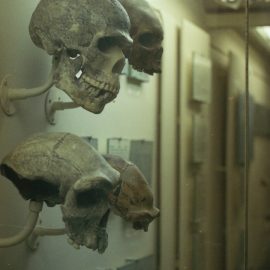

This article is an excerpt from the Shortform book guide to "The Tattooist of Auschwitz" by Heather Morris. Shortform has the world's best summaries and analyses of books you should be reading.
Like this article? Sign up for a free trial here .
In The Tattooist of Auschwitz, how did Lale set up an outside connection from Auschwitz-Birkenau concentration camp? How did his smuggling service come in handy?
Although Lale was afraid of getting caught, he found an outside connection and set up a small smuggling service inside Auschwitz-Birkenau concentration camp. It was thanks to this connection that he was able to procure Penicillin and save Gita’s life
Keep reading to learn about Lale’s secret, smuggling enterprise in Auschwitz-Birkenau concentration camp.
Auschwitz-Birkenau Concentration Camp and a Smuggling Operation
Summer turns to fall in Auschwitz-Birkenau concentration camp, and the days grow shorter as winter approaches. All this time, Lale has continued to be curious about the men working in civilian clothes. With the protection his tool bag provides, he decides it’s safe to ask them. He approaches two workers, a father and son, laying bricks for a new building. Without looking at them, Lale asks why they aren’t branded with a star and in uniforms like everyone else. At first, the son, Yuri, tells Lale to mind his own business. But the father, Victor, admonishes his son for his rudeness. Victor explains that they live in town and come here to work. They’re paid for their labor and allowed to return home in the evenings.
Lale can’t believe that anyone would choose to work in Auschwitz-Birkenau concentration camp. He tells them that he is the tattooist, and Victor looks regretful when he says it must be a busy job and that it’s about to get busier. The building they’re constructing is slated to be Crematorium One. Lale doesn’t miss the suggestion that there will be a Crematorium Two.
Lale Finds an Outside Man
Victor offers Lale a piece of hard sausage from his lunch. Yuri throws a fit and tries to stop him, but Victor reminds him that they have plenty where they live. He tells Lale to come back the next day, and he’ll try to bring more. If they can help even one prisoner, they’ll do it. Lale gets an idea. He asks if he can find a way to pay Victor, can he get some chocolate. Lale wants it to give to Gita, like he would in the real world. Victor says he’ll try. Lale walks away as snow begins to fall.
In his room, Lale becomes overwhelmed with emotion at the news of the crematoriums. But there is no time for emotions. There is work to do. He divides the sausage into small strips and wraps them in waxed paper. He looks at his fingers—soiled, thin, and calloused, not like the smooth, clean, and fleshy hands that once held rich foods at bountiful tables. How long ago that seems.
Lale takes the bits of sausage to one of the confiscated possessions warehouses, but not the one Gita works in. He stops two girls leaving work and offers them the sausage. He says he’ll bring more if they’ll smuggle some jewelry out for him, and the girls agree. Lale reminds them not to tell anyone about their agreement or where they got the food. Their lives depend on it.
The next day, Lale tells Victor he isn’t able to pay him yet but will be soon. Victor doesn’t mind. He has plenty to share. Yuri is also friendly this time and shakes Lale’s hand with a smile. Apparently, he received a talking-to about manners from his mother. Victor gives Lale two packages, one full of sausage, and the other full of chocolate.
Lale performs the same dissection and takes the wrapped pieces to the girls. He gives the girls extra to share with others, and they drop four bundles into his bag. The bundles contain cash, diamonds, rubies, and several rings. When Lale sees these items back in his room, he feels grief for the people who once loved these valuables. He also feels fear. The extra food was already risky, but getting caught with jewels in Auschwitz-Birkenau concentration camp means certain death.
He shoves the packages under his mattress and takes one ruby and a ring to Victor the next day. Lale passes the jewels through a handshake, and Victor drops the food into Lale’s open bag. Their business relationship is now official. Before Lale leaves, Victor tells him Happy New Year. It is now 1943.
Circle of Friends
As the winter of 1943 progresses, Lale’s relationships with both Victor and Gita grow stronger. Lale and Gita continue to meet on Sundays, but keeping their interactions secret gets harder because of the snow and cold. Many prisoners choose to stay in the barracks because of the bitter winter. Still, a stolen glance or passing touch of hands sustains them.
One Sunday, Lale can’t find Gita. He circles the yard, but when he doesn’t see her or her friends, he risks punishment by moving closer to the women’s camp. Suddenly, Gita’s friend Dana appears outside their block. She tells Lale that Gita has typhus and is very sick. The kapo wants to transfer her to the hospital, but Lale’s seen what happens to people at the hospital at the hands of the doctors and fears for Gita. He tells Dana to help Gita go to work each day and pretend that everything is fine until he can get some medicine.
The next morning, Lale takes all the bounty he’s collected, a small fortune, and gives it to Victor in exchange for penicillin. Victor agrees to bring some the next day. Afterward, Lale and Leon go to work. Lale tries to focus on tattooing the newcomers, but he’s consumed with worry about Gita’s health and future at Auschwitz-Birkenau concentration camp.
As soon as the last person is tattooed, Lale packs up and hurries toward Gita’s block. Dana tells him they were successful in getting her to work and keeping her hydrated. Lale gives Dana all of his breakfast rations and says he’ll have medicine soon. He doesn’t have to wait long. Victor brings him a small vial of penicillin the next day, along with the usual food packages.
A couple days later, Lale is relieved to see Dana and their other friend Ivana carrying a slightly improved Gita to work. The medicine has started to work already. Lale wants to make sure Gita never gets sick again, so he goes to Baretski and does something he never thought he’d do—asks for a favor. Lale asks for Gita to be transferred to work in the administration office, where there is heat. Baretski says he’ll try and finds great enjoyment in telling Lale that this favor will need to be returned in the future.
Gita recovers and is able to walk in the yard again. Lale continues to give her extra food to help her regain her strength. He doesn’t tell her about the favor, not knowing whether Baretski will be able to pull it off. So Gita is surprised the next day when she is called to the office. Fear overtakes her. Do they think she is too weak to work? What will become of her? Then, she is taken to a desk and told to learn her new duties from Cilka, another Jewish woman who has somehow managed to keep her beautiful long brown hair. When Gita sees Lale enter the office to receive his duties and receives a wink, she realizes he’s responsible for her new position.

———End of Preview———
Like what you just read? Read the rest of the world's best book summary and analysis of Heather Morris's "The Tattooist of Auschwitz" at Shortform .
Here's what you'll find in our full The Tattooist of Auschwitz summary :
- How a man used tattooing skills to stay alive at Auschwitz-Birkenau
- How Lale Sokolov fell in love in these unusual circumstances
- How Lale goes from concentration camp to Russian prisoner before finding freedom






